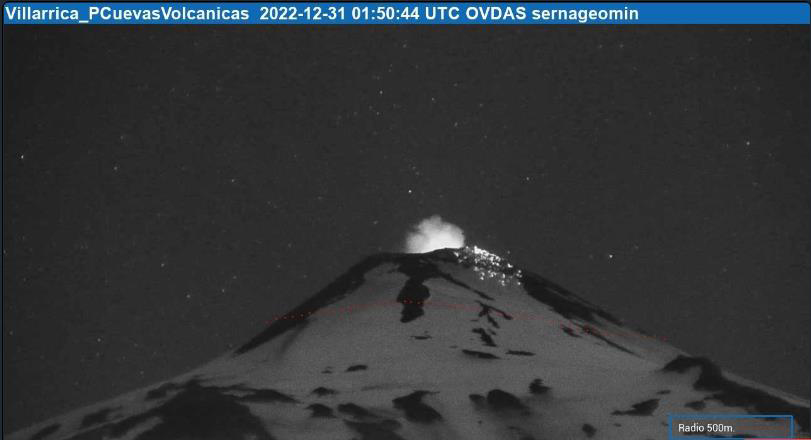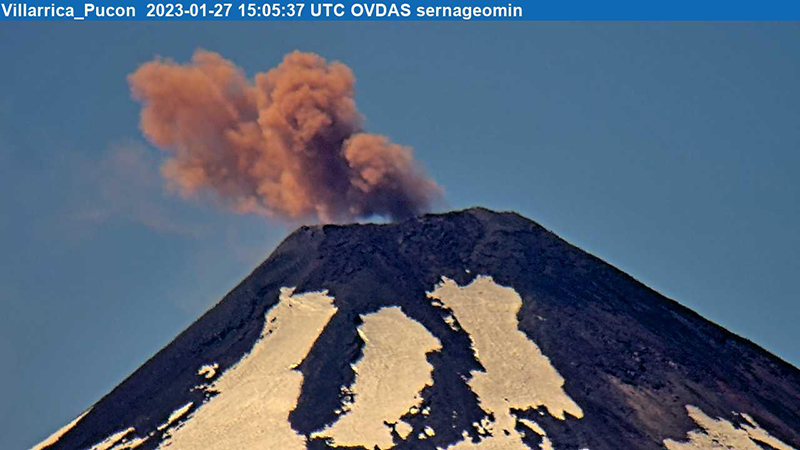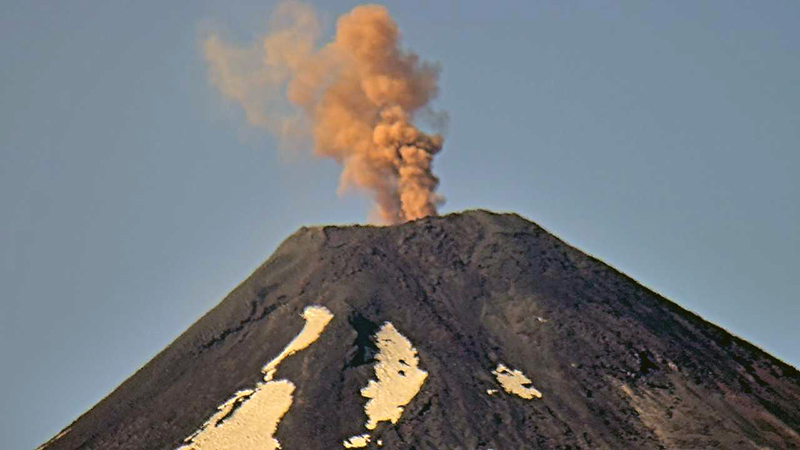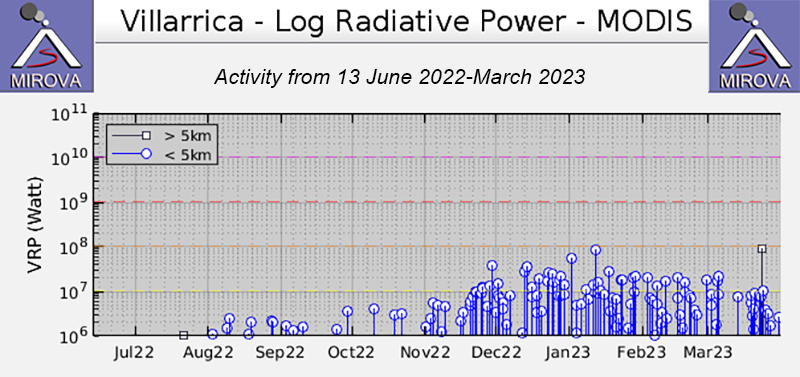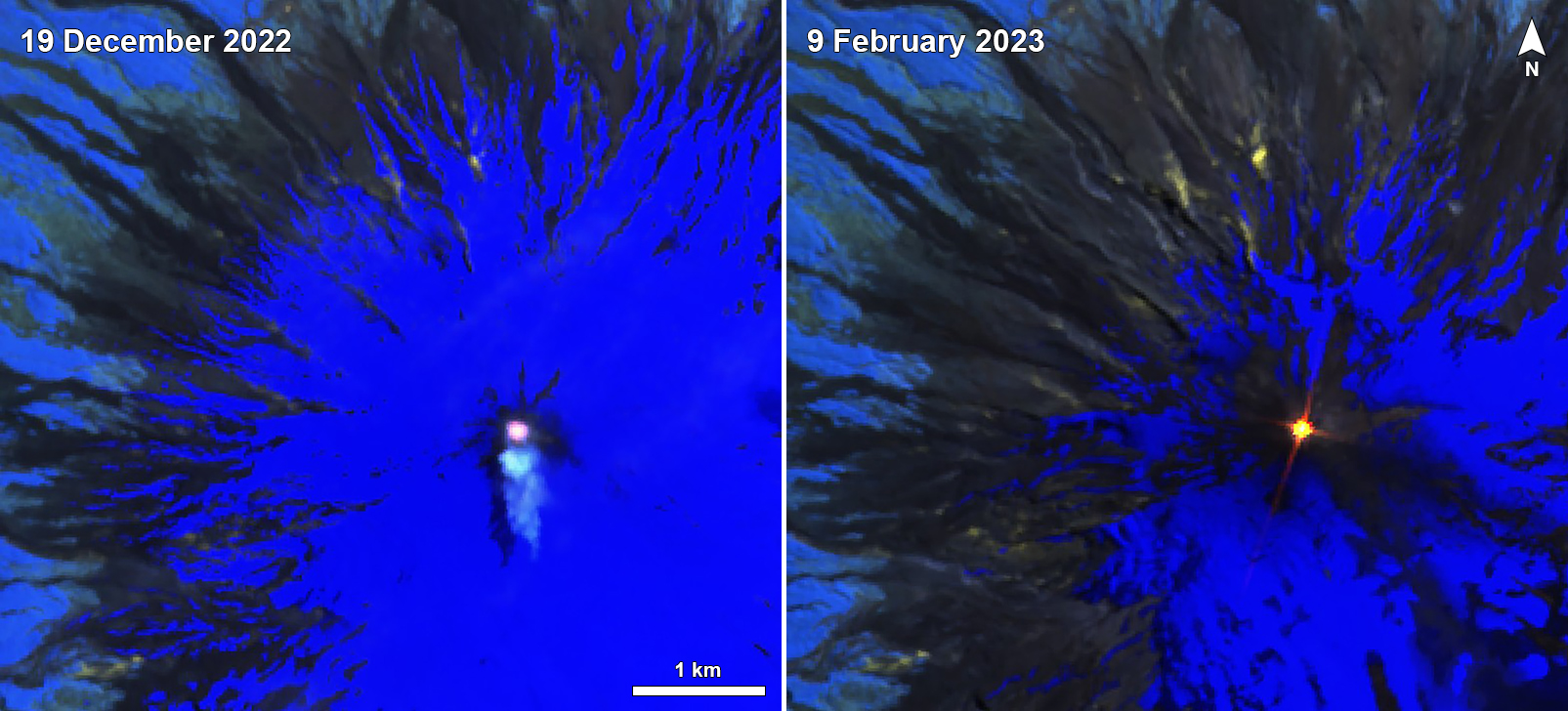Report on Villarrica (Chile) — April 2023
Bulletin of the Global Volcanism Network, vol. 48, no. 4 (April 2023)
Managing Editor: Benjamin Andrews.
Edited by Kadie L. Bennis.
Villarrica (Chile) Nighttime crater incandescence, ash emissions, and seismicity during October 2022-March 2023
Please cite this report as:
Global Volcanism Program, 2023. Report on Villarrica (Chile) (Bennis, K.L., and Andrews, B., eds.). Bulletin of the Global Volcanism Network, 48:4. Smithsonian Institution.
Villarrica
Chile
39.42°S, 71.93°W; summit elev. 2847 m
All times are local (unless otherwise noted)
Villarrica, located in central Chile, consists of a 2-km-wide caldera that formed about 3,500 years ago, located at the base of the presently active cone. Historical eruptions date back to 1558 and have been characterized by mild-to-moderate explosive activity with occasional lava effusions. The current eruption period began in December 2014 and has recently consisted of ongoing seismicity, gas-and-steam emissions, and thermal activity (BGVN 47:10). This report covers activity during October 2022 through March 2023 and describes Strombolian explosions, ash emissions, and crater incandescence. Information for this report primarily comes from the Southern Andes Volcano Observatory (Observatorio Volcanológico de Los Andes del Sur, OVDAS), part of Chile's National Service of Geology and Mining (Servicio Nacional de Geología y Minería, SERNAGEOMIN) and satellite data.
Seismicity during October consisted of discrete long-period (LP)-type events, tremor (TR), and volcano-tectonic (VT)-type events. Webcam images showed eruption plumes rising as high as 460 m above the crater rim; plumes deposited tephra on the E, S, and SW flanks within 500 m of the crater on 2, 18, 23, and 31 October. White gas-and-steam emissions rose 80-300 m above the crater accompanied by crater incandescence during 2-3 October. There was a total of 5 VT-type events, 10,625 LP-type events, and 2,232 TR-type events detected throughout the month. Sulfur dioxide data was obtained by the Differential Absorption Optical Spectroscopy Equipment (DOAS) installed 6 km in an ESE direction. The average value of the sulfur dioxide emissions was 535 ± 115 tons per day (t/d); the highest daily maximum was 1,273 t/d on 13 October. These values were within normal levels and were lower compared to September. During the night of 3-4 October Strombolian activity ejected blocks as far as 40 m toward the NW flank. Small, gray-brown ash pulses rose 60 m above the crater accompanied white gas-and-steam emissions that rose 40-300 m high during 4-5 October. In addition, crater incandescence and Strombolian explosions that ejected blocks were reported during 4-5 and 9-11 October. Based on satellite images from 12 October, ballistic ejecta traveled as far as 400 m and the resulting ash was deposited 3.2 km to the E and SE and 900 m to the NW.
Satellite images from 14 October showed an active lava lake that covered an area of 36 square meters in the E part of the crater floor. There was also evidence of a partial collapse (less than 300 square meters) at the inner SSW crater rim. POVI posted an 18 October photo that showed incandescence above the crater rim, noting that crater incandescence was visible during clear weather nights. In addition, webcam images at 1917 showed lava fountaining and Strombolian explosions; tourists also described seeing splashes of lava ejected from a depth of 80 m and hearing loud degassing sounds. Tephra deposits were visible around the crater rim and on the upper flanks on 24 October. On 25 October SERNAGEOMIN reported that both the number and amplitude of LP earthquakes had increased, and continuous tremor also increased; intense crater incandescence was visible in satellite images. On 31 October Strombolian explosions intensified and ejected material onto the upper flanks.
Activity during November consisted of above-baseline seismicity, including intensifying continuous tremor and an increase in the number of LP earthquakes. On 1 November a lava fountain was visible rising above the crater rim. Nighttime crater incandescence was captured in webcam images on clear weather days. Strombolian explosions ejected incandescent material on the NW and SW flanks during 1, 2, and 6-7 November. POVI reported that the width of the lava fountains that rose above the crater rim on 2 November suggested that the vent on the crater floor was roughly 6 m in diameter. Based on reports from observers and analyses of satellite imagery, material that was deposited on the upper flanks, primarily to the NW, consisted of clasts up to 20 cm in diameter. During an overflight on 19 November SERNAGEOMIN scientists observed a cone on the crater floor with an incandescent vent at its center that contained a lava lake. Deposits of ejecta were also visible on the flanks. That same day a 75-minute-long series of volcano-tectonic earthquakes was detected at 1940; a total of 21 events occurred 7.8 km ESE of the crater. Another overflight on 25 November showed the small cone on the crater floor with an incandescent lava lake at the center; the temperature of the lava lake was 1,043 °C, based data gathered during the overflight.
Similar seismicity, crater incandescence, and gas-and-steam emissions continued during December. On 1 December incandescent material was ejected 80-220 m above the crater rim. During an overflight on 6 December, intense gas-and-steam emissions from the lava lake was reported, in addition to tephra deposits on the S and SE flanks as far as 500 m from the crater. During 7-12 December seismicity increased slightly and white, low-altitude gas-and-steam emissions and crater incandescence were occasionally visible. On 24 December at 0845 SERNAGEOMIN reported an increase in Strombolian activity; explosions ejected material that generally rose 100 m above the crater, although one explosion ejected incandescent tephra as far as 400 m from the crater onto the SW flank. According to POVI, 11 explosions ejected incandescent material that affected the upper SW flank between 2225 on 25 December to 0519 on 26 December. POVI recorded 21 Strombolian explosions that ejected incandescent material onto the upper SW flank from 2200 on 28 December to 0540 on 29 December. More than 100 Strombolian explosions ejected material onto the upper W and NW flanks during 30-31 December. On 30 December at 2250 an explosion was detected that generated an eruptive column rising 120 m above the crater and ejecting incandescent material 300 m on the NW flank (figure 120). Explosions detected at 2356 on 31 December ejected material 480 m from the crater rim onto the NW flank and at 0219 material was deposited on the same flank as far as 150 m. Both explosions ejected material as high as 120 m above the crater rim.
During January 2023, Strombolian explosions and lava fountaining continued mainly in the crater, ejecting material 100 m above the crater. Gas-and-steam emissions rose 40-260 m above the crater and drifted in different directions, and LP-type events continued. Emissions during the night of 11 January including some ash rose 80 m above the crater and as far as 250 m NE flank. POVI scientists reported about 70 lava fountaining events from 2130 on 14 January to 0600 on 15 January. At 2211 on 15 January there was an increase in frequency of Strombolian explosions that ejected incandescent material 60-150 m above the crater. Some ashfall was detected around the crater. POVI noted that on 19 January lava was ejected as high as 140 m above the crater rim and onto the W and SW flanks. Explosion noises were heard on 19 and 22 January in areas within a radius of 10 km. During 22-23 January Strombolian explosions ejected incandescent material 60-100 m above the crater that drifted SE. A seismic event at 1204 on 27 January was accompanied by an ash plume that rose 220 m above the crater and drifted E (figure 121); later that same day at 2102 an ash plume rose 180 m above the crater and drifted E.
Seismicity, primarily characterized by LP-type events, and Strombolian explosions persisted during February and March. POVI reported that three explosions were heard during 1940-1942 on 6 February, and spatter was seen rising 30 m above the crater rim hours later. On 9 February lava fountains were visible rising 50 m above the crater rim. On 17 February Strombolian explosions ejected material 100 m above the crater rim and onto the upper SW flank. Webcam images from 20 February showed two separate fountains of incandescent material, which suggested that a second vent had opened to the E of the first vent. Spatter was ejected as high as 80 m above the crater rim and onto the upper NE flank. A sequence of Strombolian explosions was visible from 2030 on 20 February to 0630 on 21 February. Material was ejected as high as 80 m above the crater rim and onto the upper E flank. LP-type earthquakes recorded 1056 and at 1301 on 27 February were associated with ash plumes that rose 300 m above the crater and drifted NE (figure 122). Crater incandescence above the crater rim was observed in webcam images on 13 March, which indicated Strombolian activity. POVI posted a webcam image from 2227 on 18 March showing Strombolian explosions that ejected material as high as 100 m above the crater rim. Explosions were heard up to 8 km away. On 19 March at 1921 an ash emission rose 340 m above the crater and drifted NE. On 21 and 26 March Strombolian explosions ejected material 100 and 110 m above the crater rim, respectively. On 21 March Strombolian explosions ejected material 100 m above the crater rim. Low-intensity nighttime crater incandescence was detected by surveillance cameras on 24 March.
Infrared MODIS satellite data processed by MIROVA (Middle InfraRed Observation of Volcanic Activity) detected an increase in thermal activity during mid-November, which corresponds to sustained Strombolian explosions, lava fountaining, and crater incandescence (figure 123). This activity was also consistently captured on clear weather days throughout the reporting period in Sentinel-2 infrared satellite images (figure 124).
Geological Summary. The glacier-covered Villarrica stratovolcano, in the northern Lakes District of central Chile, is ~15 km south of the city of Pucon. A 2-km-wide caldera that formed about 3,500 years ago is located at the base of the presently active, dominantly basaltic to basaltic-andesite cone at the NW margin of a 6-km-wide Pleistocene caldera. More than 30 scoria cones and fissure vents are present on the flanks. Plinian eruptions and pyroclastic flows that have extended up to 20 km from the volcano were produced during the Holocene. Lava flows up to 18 km long have issued from summit and flank vents. Eruptions documented since 1558 CE have consisted largely of mild-to-moderate explosive activity with occasional lava effusion. Glaciers cover 40 km2 of the volcano, and lahars have damaged towns on its flanks.
Information Contacts: Servicio Nacional de Geología y Minería (SERNAGEOMIN), Observatorio Volcanológico de Los Andes del Sur (OVDAS), Avda Sta María No. 0104, Santiago, Chile (URL: http://www.sernageomin.cl/); Proyecto Observación Villarrica Internet (POVI) (URL: http://www.povi.cl/); MIROVA (Middle InfraRed Observation of Volcanic Activity), a collaborative project between the Universities of Turin and Florence (Italy) supported by the Centre for Volcanic Risk of the Italian Civil Protection Department (URL: http://www.mirovaweb.it/); Sentinel Hub Playground (URL: https://www.sentinel-hub.com/explore/sentinel-playground).


